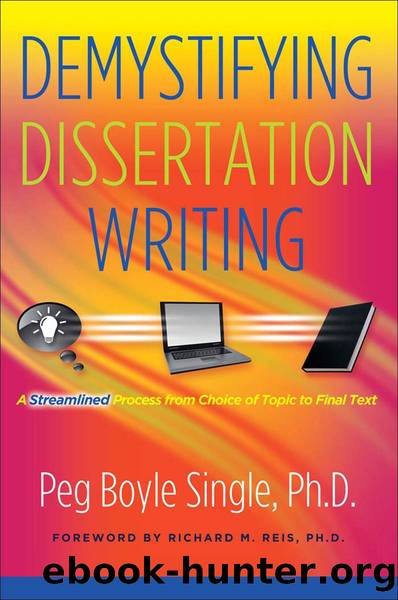Demystifying Dissertation Writing: A Streamlined Process from Choice of Topic to Final Text by Single Peg Boyle

Author:Single, Peg Boyle [Single, Peg Boyle]
Language: eng
Format: epub
Publisher: Stylus Publishing
Published: 2011-06-29T16:00:00+00:00
5.3. Providing Useful Feedback
Around the time that I begin talking about focus statements with the students in my writing seminar, we are regularly sharing our work with one another. Naturally, we solicit and give feedback and suggestions to one another, so I take some time to set out rules for soliciting and providing useful and supportive feedback.
First, I want to debunk the myth that knowledge moves forward through conflict. That is not the case; although you might have heard of seminars in which students’ work is shredded and conferences where a speaker is skewered, these are few and far between. Knowledge moves forward through collegial give and take. Even if conflict is the primary medium for moving forward in a specific field, I do not allow it in my seminar. My students can engage in scholarly conflicts outside the classroom; inside the classroom, we engage in supportive and constructive critiques.
After stating my beliefs about the futility of conflict, I share my wish that we treat each other graciously and kindheartedly. That does not mean that we do not criticize one another; we do, but we give constructive criticism. In my class, we subscribe to what Robert Nash calls “the ‘Golden Rule’ of seminar conversation: Respond to others in the class the way that you would like them to respond to you.” 1
We have three rules that we follow in class. Rule 1: Surround constructive criticism with encouragement. Anyone who has ever taken management or supervisory training has probably heard of this rule. Whenever we provide feedback to each other, we first point out at least one strength of the interactive note, focus statement, or outline, and then present our question or constructive criticism.
Rule 2: Be more explicit rather than less explicit. Depending on body language and tone of voice with which it is said, people can interpret the phrase “What did you mean by that?” as genuinely inquisitive or highly dismissive. I encourage my students to be precise while framing their questions—the more precise, the less likely that the questions will be misunderstood. Rather than “What did you mean by that?” I suggest questions such as: “I’m intrigued by your theory. What did you mean by using it in that context?” or “I don’t quite understand what you mean by [a specific point]. Could you please explain it a little more?”
Rule 3: Own your comments. By owning your comments, you allow the presenter to answer you in a constructive manner. In my class, I do not allow comments such as “That theory doesn’t make sense.” Rather, we stick to phrases like “I don’t understand the theory you are presenting” or “I don’t understand why you are focusing on that theory.”
I leave you with a another quote from Robert Nash that encapsulates my perspective on giving feedback, a perspective that I hope you too will embrace: “Critique and feedback, when appropriate, ought always to come out of a framework of generosity and compassion, and always with an intention to make the other person look good.
Download
This site does not store any files on its server. We only index and link to content provided by other sites. Please contact the content providers to delete copyright contents if any and email us, we'll remove relevant links or contents immediately.
The Art of Coaching Workbook by Elena Aguilar(48065)
Trainspotting by Irvine Welsh(20055)
Twilight of the Idols With the Antichrist and Ecce Homo by Friedrich Nietzsche(17706)
Fangirl by Rainbow Rowell(7834)
Periodization Training for Sports by Tudor Bompa(7328)
Change Your Questions, Change Your Life by Marilee Adams(6641)
This Is How You Lose Her by Junot Diaz(5773)
Grit by Angela Duckworth(4737)
Red Sparrow by Jason Matthews(4666)
Asking the Right Questions: A Guide to Critical Thinking by M. Neil Browne & Stuart M. Keeley(4576)
Paper Towns by Green John(4169)
Room 212 by Kate Stewart(4107)
Ken Follett - World without end by Ken Follett(3972)
The Sports Rules Book by Human Kinetics(3588)
Housekeeping by Marilynne Robinson(3401)
The Motorcycle Diaries by Ernesto Che Guevara(3332)
Introduction to Kinesiology by Shirl J. Hoffman(3301)
Exercise Technique Manual for Resistance Training by National Strength & Conditioning Association(3292)
Double Down (Diary of a Wimpy Kid Book 11) by Jeff Kinney(3272)
